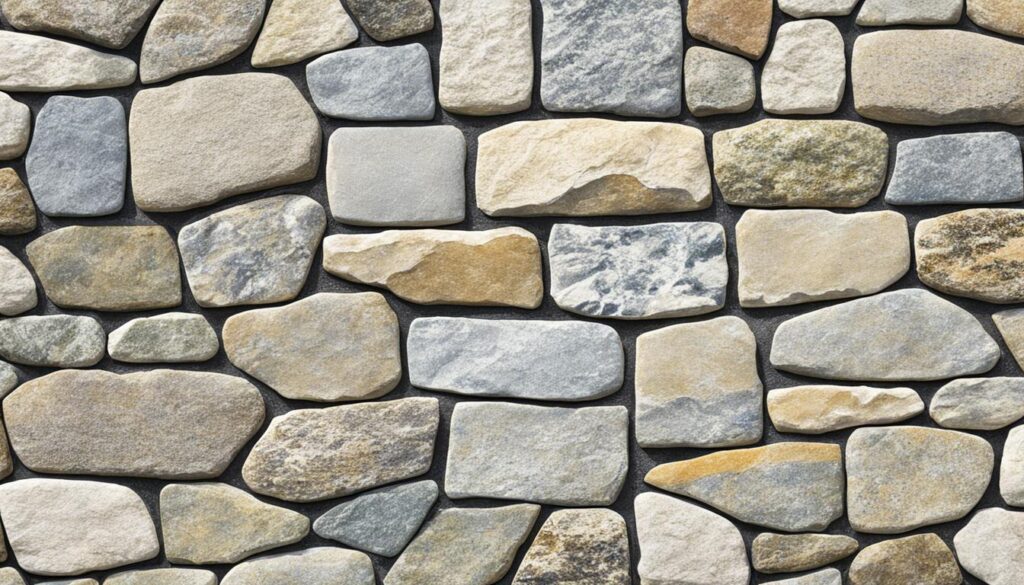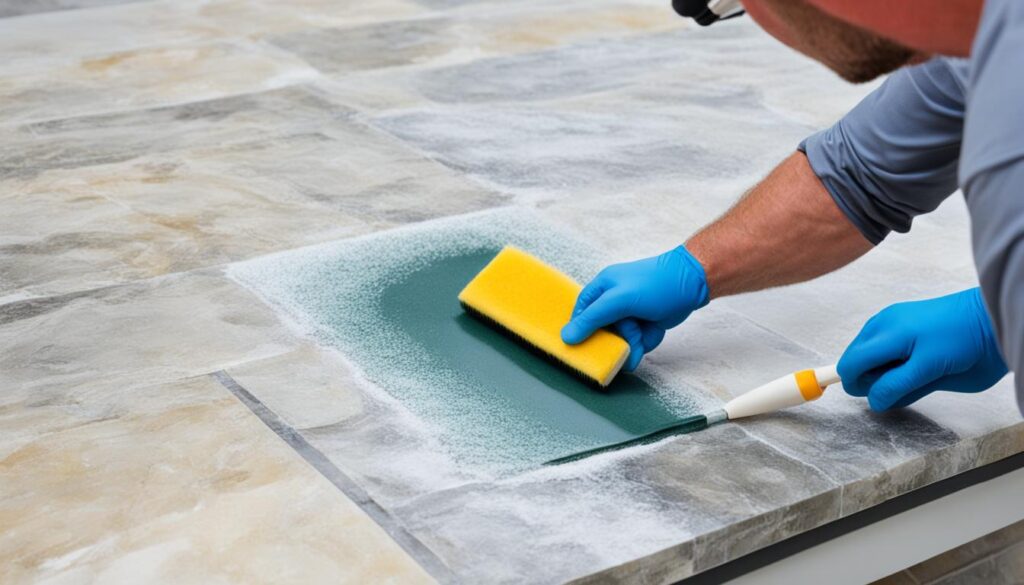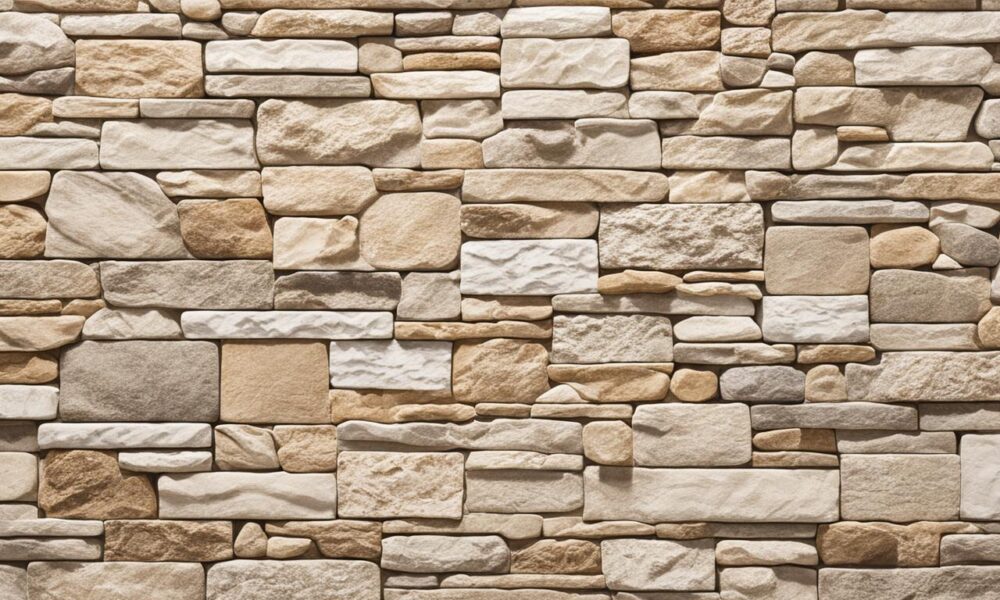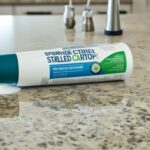DIViewer Guide to Natural Stone Sealing: Shield Your Surfaces
Sealing natural stone is key to keeping its beauty and strength. With the right stone sealants, you can protect your stone for a long time. Everyday use can harm surfaces, but sealing protects against this.
Whether you have a gorgeous granite countertop or a beautiful marble floor, sealing is a must. It keeps your stone looking good and safe.
Taking care of natural stone means more than just cleaning. You need to follow best practices for keeping surfaces in great shape. This guide offers insights into stone care and sealing benefits. Learn to keep your stone surfaces elegant and durable. With our tips, your stone will stay perfect for many years.
Key Takeaways
- Understand the importance of natural stone protection for longevity and aesthetics.
- Learn about various surface sealing techniques to enhance stone resilience.
- Discover stone care best practices to maintain the natural beauty of your surfaces.
- Recognize the role of effective stone sealants in stain and damage prevention.
- Gain knowledge on the advantages of regular maintenance and sealing of natural stone.
Why Sealing Natural Stone Surfaces is Essential
Sealing natural stone surfaces keeps their beauty and extends their life. It’s key to know how porosity and absorption affect different stones.
Understanding Porosity and Absorption
Stone types like granite, marble, and limestone have different porosity levels. For instance, granite has low porosity, but limestone is very porous1. These stones can soak up water, oils, and more, which can cause stains and damage1. Applying sealant protects them by reducing how much they absorb. This helps prevent stains and safeguards against damage1.
Protecting Against Stains and Damage
Sealants stop natural stone surfaces from soaking up liquids, avoiding water and oil stains1. They also protect against scratches and wear1. While they can’t stop all damage, they make stones more resistant1.
Stones like marble and granite need regular sealing. Marble is easily stained and etched, so it needs more care2. Granite benefits from sealing to keep away stains2.
It’s often best to get a pro for a sealing job. They avoid mistakes like streaking, keeping the stone’s natural beauty1. Boston Stone Restoration offers expert sealing, cleaning, and protection services for all stone types in homes and businesses3.
In Houston, modern and classic styles blend in architecture, featuring natural stone. It’s chosen for its durability and timeless look2.
For DIY care, check if sealants are working by dropping water on the stone to see if it beads up3. Regular checks and professional sealing are the best defense. They keep stone surfaces beautiful and sturdy for a long time.
| Type of Stone | Porosity Level | Sealing Frequency | Recommended Usage |
|---|---|---|---|
| Granite | Slightly Porous | Periodic | High-use areas |
| Marble | Highly Porous | Regular | Decorative Interiors |
| Limestone | Highly Porous | Regular | Interior Surfaces |
| Slate | Slightly Porous | Occasional | Floors, Countertops |
| Travertine | Highly Porous | Regular | Walls, Floors |
Types of Natural Stone Sealers
Choosing the best sealer for your stone surfaces is key to keeping their beauty. There are main types to think about: topical sealers and penetrating sealers. Each one offers unique benefits and affects how your stone looks and works.
Topical Sealers
Topical sealers are easy to apply and make the stone’s surface shine. They create a waterproof cover that keeps spills and stains away4. Some can even change the stone’s color or look, giving it a nice boost4.
But, they might not stick well to polished stones like granite or marble4. Even so, their quick use and the way they enhance looks make them a popular choice.
Penetrating Sealers
Penetrating sealers soak into the stone and protect it from inside. They stop liquids from staining the stone by making the surface more tense4. These sealers are a top pick for stones that soak up more4. They keep the stone’s natural look while still protecting it, which is a big plus for those who love the original look of their stone4.

When choosing between topical and penetrating sealers, think about what you need and the stone type. Look at things like how much the stone soaks up, the look you want, and where it will be used. Both types of sealers are crucial for keeping your stone beautiful and strong for a long time.
How to Select the Best Sealer for Natural Stone
Choosing the right sealer is key to keeping natural stone looking great. It’s important to know the types of sealers and which one fits your stone. This ensures your stone stays protected and looks good for a long time.
Matching Sealer Type to Stone Type
First, figure out what kind of stone you have. Porous stones like limestone need penetrating sealers. These sealers soak in and protect the stone while letting it breathe5. Non-porous stones, like granite, are best with surface sealers. These create a top layer that makes colors richer and guards against stains from oil and water5.
For marble, you need something that fights acid and is safe for food. This helps prevent damage that isn’t a sign to reseal6. Granite works well with safe impregnators and certain resins. But, stay away from some resins that can hurt the stone6. Omni-Sealers offers many options for different needs6.
| Stone Type | Recommended Sealer | Application Tips |
|---|---|---|
| Limestone / Sandstone | Penetrating Sealer | Clean surface, wear gloves, ventilate area, test on a small area before full application6 |
| Granite | Impregnators, Fluorocarbon Aliphatic Resins | Avoid linseed, silicon, and siloxane resins6 |
| Marble | Acid-resistant, Food-safe Impregnators | Etching is not an indicator to reseal6 |
Evaluating Sealer Performance and Longevity
How long a sealer lasts is very important. Topical sealers can change the stone’s color if they are not high quality. They protect against oil and water but might not last as long as impregnators. Impregnators go into the stone and last longer6. PVC sealers are also very strong. They can handle bad weather, UV rays, and pool chemicals, which is great for outside5.
To keep your stone safe and looking nice, you need to maintain and seal it properly. The best sealers stop water damage and prevent algae or mold5. For outdoor use, a good sealer also keeps weather damage and stains away. This helps your stone stay in great shape for a long time5.
DIY Guide to Natural Stone Sealing: Protecting Your Investment
Sealing your stone surfaces is key. It makes them look better and last longer. This guide is for homeowners ready to seal their own stones. You’ll learn what tools you need, how to do it, and get expert advice for a top-notch result.
Essential Tools and Materials
First, collect all the sealing tools and materials you need.
- Quality stone sealer (penetrating or topical depending on your stone type)
- Clean microfiber cloths
- Foam applicator or paintbrush
- Plastic sheeting and painter’s tape (for protecting adjacent areas)
- Protective gloves and eye protection
- Neutral pH stone cleaner (such as Modern Stone Care’s marble safe floor cleaner)7
- Vacuum or broom to remove debris
Comprehensive Step-by-Step Instructions
To seal your stone properly, follow these steps:
- Preparation: Clean the stone surface with a neutral pH cleaner and let it dry. This is to ensure no residue affects the sealer.
- Application: Evenly apply the sealer with a foam applicator or brush. Follow the manufacturer’s rate and instructions closely.
- Absorption: Let the sealer soak into the stone as recommended. This varies by stone type and porosity.
- Buffing: Wipe off extra sealer with a microfiber cloth to prevent streaks or stickiness.
- Curing: Allow the surface to cure as per the sealer’s guidelines. This can take hours or days.
Expert Tips for a Professional Finish
For a professional seal, keep these tips in mind:
- Frequency: Seal your stone surfaces yearly, or more if needed, especially in busy homes7.
- Choosing Sealers: Pick the right sealer for your stone. Penetrating sealers protect without changing appearance, while topical sealers add shine but need more care8.
- Handling Acid-Sensitive Stones: For acid-sensitive stones like marble, avoid vinegar or citrus cleaners8.
- Regular Maintenance: Maintain surfaces with a neutral pH cleaner to keep the sealer working well7.

Maintaining Your Natural Stone Surfaces After Sealing
To keep your sealed stone surfaces looking good, it’s important to care for them well. This means sticking to a daily maintenance routine. By doing this, your stone surfaces will stay protected and look nice for longer.
Getting a professional to seal your stone saves you time and ensures the job is done right9. They have special skills and tools that most people don’t9. Plus, it can make your business space look better9.
After sealing, keeping up with cleaning is key. Use cleaners that are gentle and designed for sealed surfaces. This stops damage and keeps spills and dirt from soaking in9.
Deciding when to reseal your stone involves looking at how often it’s used, the weather, and the stone’s type9. To keep the seal strong, check how well it repels water now and then. This helps you know when it’s time for a new coat.
For tips on keeping your sealed stone in top shape, check out this detailed guide to natural stone sealing. Regular upkeep not only keeps the stone looking great but also helps your investment last longer.
Common Mistakes to Avoid When Sealing Stone
Avoiding common mistakes during stone sealing is key for its protection and look. It’s vital to follow the manufacturer’s instructions for correct use. Also, preparing the surface well is important to avoid problems that could weaken the sealant.
Over-applying or Under-applying Sealer
Applying too much or too little sealer is a big mistake. Too much sealer makes the surface sticky and ugly. Not enough sealer means the stone might get stains and moisture damage. Applying the sealer evenly ensures it covers the stone well without soaking it too much.
Ignoring Manufacturer Instructions
Not following the manufacturer’s instructions can lead to trouble. Each sealer needs to be applied a certain way, with specific drying times. Following these instructions helps the sealer work best, keeping moisture and stains away. It also helps bring out the stone’s natural colors and makes it last longer10. Using the right cleaning products, like pH-neutral ones, also avoids damage10.
Improper Surface Preparation
Getting the surface right before sealing is crucial. If you don’t clean the stone well, dirt and grime will get sealed in, causing a bad look. Also, not fixing stains or damage first can make the seal look uneven and unattractive. Washing with high-pressure water can remove deep stains and dirt, making the stone ready for sealing11.
To keep your natural stone looking good and protected, avoid these common mistakes. Use the sealer properly and prepare the surface correctly. Regular care and getting advice from stone care experts will keep your stone beautiful and valuable for a long time10.
Conclusion
Sealing natural stone is very important. We have talked about the many benefits of sealing. These include making the stone last longer and look better12. It also helps protect against water and stains. More people are choosing natural stone for its beauty and green benefits. We also looked at how impregnator sealers help keep these stones safe with less work13.
Sealing stone right is key to keeping it in top shape. Good sealing means even strong stones look great and last longer14. We stressed that taking care of your stone and choosing the right sealer stops damage. This helps your stone last longer12.
DIY fans can get good results with the right tools and ways. It matters if you pick a topical or impregnator sealer. You need to know what your stone needs for it to work well and last13. Follow our detailed steps and advice. Then you can protect your stone and make your home more beautiful and valuable.
FAQ
Why is sealing natural stone surfaces essential?
What are the main types of natural stone sealers?
How do I choose the best sealer for my natural stone?
What tools and materials are essential for DIY natural stone sealing?
What are the steps for sealing natural stone surfaces?
How can I maintain my natural stone surfaces after sealing?
What are some common mistakes to avoid when sealing stone?
Source Links
- Why Sealing Is Important for Stone Tile Restoration
- The Ultimate Guide to Caring for Your Natural Stone Surfaces
- Stone Care Guide for Homeowners | Boston Stone Restoration
- Difference Between Penetrating and Topical Stone Sealers
- Exterior Stone Sealers – Best Sealers – TSS Pro Sealants
- Menzie Stone Company | How To Seal Your Stone
- A Guide to Protecting Your Stone Surfaces
- Natural Stone Tile Step-by-Step Care & Maintenance
- Natural Stone Sealing: The Complete Guide – Enviro Clean and Capture
- The Grout Doctor Oakland
- The Complete Guide to Patio Sealing: DIY Tips and Techniques for Long-Lasting Protection
- The Ultimate Guide to Natural Stone Veneer: 2023 – Natural Stone Veneer
- A Comprehensive Guide to Sealing Paving: Types, Techniques, and Tips
- Stone Cleaning Resources & Education



